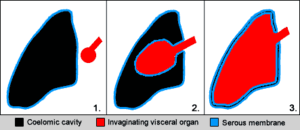

| Serous membrane | |
|---|---|

Stomach. (Serosa is labeled at far right, and is colored yellow.)
| |
| Details | |
| Precursor | Mesoderm |
| Identifiers | |
| Latin | tunica serosa |
| MeSH | D012704 |
| FMA | 9581 |
| Anatomical terminology | |
 |
| This article is one of a series on the |
| Gastrointestinal wall |
|---|
|
General structure |
|
Specific |
|
Organs |
|
|

The serous membrane (orserosa) is a smooth tissue membraneofmesothelium lining the contents and inner walls of body cavities, which secrete serous fluid to allow lubricated sliding movements between opposing surfaces. The serous membrane that covers internal organs is called visceral, while the one that covers the cavity wall is called parietal. For instance the parietal peritoneum is attached to the abdominal wall and the pelvic walls.[2] The visceral peritoneum is wrapped around the visceral organs. For the heart, the layers of the serous membrane are called parietal and visceral pericardium. For the lungs they are called parietal and visceral pleura. The visceral serosa of the uterus is called the perimetrium. The potential space between two opposing serosal surfaces is mostly empty except for the small amount of serous fluid.[3]
The Latin anatomical name is tunica serosa. Serous membranes line and enclose several body cavities, also known as serous cavities, where they secrete a lubricating fluid which reduces friction from movements. Serosa is entirely different from the adventitia, a connective tissue layer which binds together structures rather than reducing friction between them. The serous membrane covering the heart and lining the mediastinum is referred to as the pericardium, the serous membrane lining the thoracic cavity and surrounding the lungs is referred to as the pleura, and that lining the abdominopelvic cavity and the viscera is referred to as the peritoneum.
Serous membranes have two layers. The parietal layers of the membranes line the walls of the body cavity (pariet- refers to a cavity wall). The visceral layer of the membrane covers the organs (the viscera). Between the parietal and visceral layers is a very thin, fluid-filled serous space, or cavity.[4]
Each serous membrane is composed of a secretory epithelial layer and a connective tissue layer underneath.
For the heart, the layers of the serous membrane are called the parietal pericardium, and the visceral pericardium (sometimes called the epicardium). Other parts of the body may also have specific names for these structures. For example, the serosa of the uterus is called the perimetrium.

The pericardial cavity (surrounding the heart), pleural cavity (surrounding the lungs) and peritoneal cavity (surrounding most organs of the abdomen) are the three serous cavities within the human body. While serous membranes have a lubricative role to play in all three cavities, in the pleural cavity it has a greater role to play in the function of breathing.
The serous cavities are formed from the intraembryonic coelom and are basically an empty space within the body surrounded by serous membrane. Early in embryonic life visceral organs develop adjacent to a cavity and invaginate into the bag-like coelom. Therefore, each organ becomes surrounded by serous membrane - they do not lie within the serous cavity. The layer in contact with the organ is known as the visceral layer, while the parietal layer is in contact with the body wall.
In the human body, there are three serous cavities with associated serous membranes:
The two layers of serous membranes are named parietal and visceral. Between the two layers is a thin fluid filled space.[4] The fluid is produced by the serous membranes and stays between the two layers to reduce friction between the walls of the cavities and the internal organs when they move with respect to one another, such as when the lungs inflate or the heart beats. Such movement could otherwise lead to inflammation of the organs.[4]
All serous membranes found in the human body formed ultimately from the mesoderm of the trilaminar embryo. The trilaminar embryo consists of three relatively flat layers of ectoderm, endoderm (also known as "entoderm") and mesoderm.
As the embryo develops, the mesoderm starts to segment into three main regions: the paraxial mesoderm, the intermediate mesoderm and the lateral plate mesoderm.
The lateral plate mesoderm later splits in half to form two layers bounding a cavity known as the intraembryonic coelom. Individually, each layer is known as splanchnopleure and somatopleure.
The intraembryonic coelom can now be seen as a cavity within the body which is covered with serous membrane derived from the splanchnopleure. This cavity is divided and demarcated by the folding and development of the embryo, ultimately forming the serous cavities which house many different organs within the thorax and abdomen.
Mesotheliomas are neoplasias that are relatively specific for serous membranes. The modified Müllerian-derived serous membranes that surrounds the ovaries in females can give rise to serous tumors, a solid to papillary tumor type that may also arise within the uterus.
This Wikipedia entry incorporates text from the freely licensed Connexions [1] edition of Anatomy & Physiology [2] text-book by OpenStax College
{{cite book}}: CS1 maint: location missing publisher (link)
|
Anatomy of the gastrointestinal tract, excluding the mouth
| |||||||||||||||||||||
|---|---|---|---|---|---|---|---|---|---|---|---|---|---|---|---|---|---|---|---|---|---|
| Upper |
| ||||||||||||||||||||
| Lower |
| ||||||||||||||||||||
| Wall |
| ||||||||||||||||||||
|
Anatomy of the lower respiratory tract
| |||||||
|---|---|---|---|---|---|---|---|
| Respiratory tree |
| ||||||
| Lungs |
| ||||||
|
Anatomy of the peritoneum and mesentery
| |||||||||
|---|---|---|---|---|---|---|---|---|---|
| General |
| ||||||||
| Abdominal |
| ||||||||
| Pelvic |
| ||||||||
| Spaces |
| ||||||||
| Authority control databases: National |
|
|---|